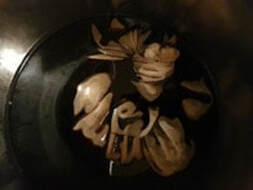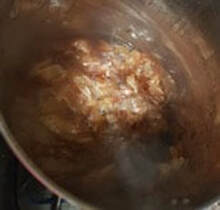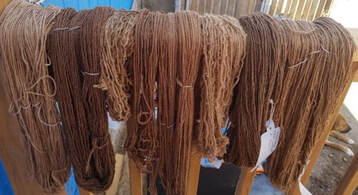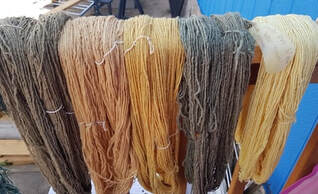Sue V. BegayNavajo Weaving BFA Student, CA315 Wool Processing II
I prepared the black walnut skin with a pre-soaking. Pre-soaking is required because the black walnut is very hard. I had my black walnut soaking for one day and one night. I prepared the labels on the skein and wet the weft. For this project, I used heather gray and blanche white from Brown Sheep Company along side some of my hand spun wool. After my skeins and weft were labelled, I dipped them in the prepared boiling pots of water. The water I used is from the unconfined aquifer water from Narrow Canyon. All the dyeing is done with unconfined aquifer water. I repeated the same process for the yellow skin onions- although I did not have to pre-soak. For each dye, I made two groups: one set made with alum and another set without alum.
My experience with dyeing with yellow onion skin and black walnut was very exciting. The colors of the weft are gorgeous with both yellow onion skin and black walnut. I learned about the slight various of natural plants as well as the differences using machine spun vs hand spun wool. Ultimately, what my major take away this week is that the beauty and gorgeous colors that comes from Mother Earth are treasures. Watching how the color comes alive. 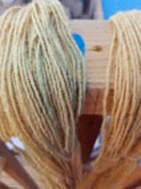 UGG - My fault - Sorry, wool! UGG - My fault - Sorry, wool! Here are some other practical take aways I learned this past week: Lesson Learned: The wool is still very hot even after two baths. Lesson Learned: Never mix a pre-dyed skein with your skein you wish to color. Lesson Learned: Be patient and let the colors work. BIG Lesson Learned: This is what not to do. I put in a white skein and put a sky-blue skein on top of it and the color transferred onto the white skein. I can still use this in my pictorial rug as a corn tassel or streaks in the skyline. One of a kind weft. I am very honored to be in this class even though we are distance learning. It was absolute great day of hands on activities and I am looking forward to another great lesson. But for now...I saved some of my black walnut and I'll be testing it out with some Navajo churro raw wool.
2 Comments
Beverly Sherratt
7/6/2020 11:25:26 am
Hi Sue,
Reply
11/19/2022 02:16:16 pm
The black walnut is very hard. I had my black walnut soaking for one day and one night. I prepared the labels on the skein and wet the weft. For this project, Thank you for sharing your great post!
Reply
Leave a Reply. |
Categories
All
Archives
October 2021
|
SocialsALL PHOTOS IMAGES ARE COPYRIGHT PROTECTED. PHOTO IMAGES USE IS SUBJECT TO PERMISSION BY THE NAVAJO CULTURAL ARTS PROGRAM. NO FORM OF REPRODUCTION IS PERMITTED WITHOUT WRITTEN PERMISSION FROM THE NAVAJO CULTURAL ARTS PROGRAM. |
Featured Pages |

